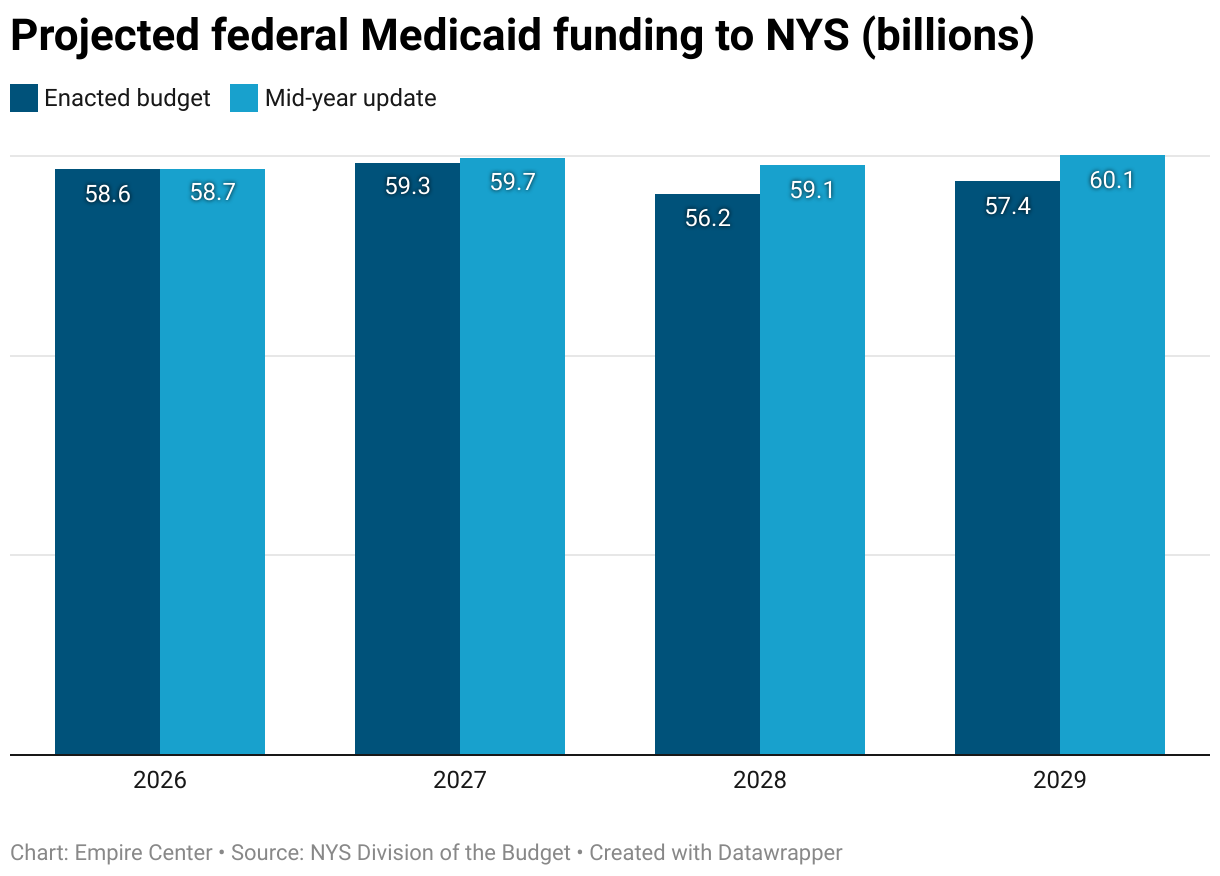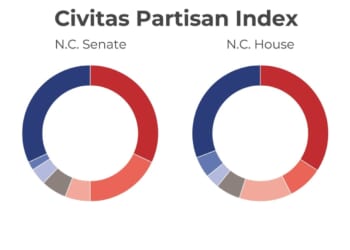A new fiscal report from the state Budget Division suggests federal funding cuts will hit New York’s health-care budget less severely than officials have previously warned.
A financial plan update released last week estimates that Washington’s tax and spending package, signed by President Trump this summer, will add $2.6 billion to the state’s health costs in fiscal 2027, rising to $3.6 billion in 2028 and 2029.
However, most of those costs could be avoided if the state wins approval to reconfigure its Essential Plan, as proposed to federal regulators in September.
Meanwhile, the Budget Division has increased – not decreased – its projections of how federal Medicaid funding the state will receive in years ahead. Compared to figures it published in May, the division anticipates an additional $444 million in federal Medicaid support in fiscal 2027, $2.8 billion in 2028 and $2.6 billion in 2029.

The division also estimates that enrollment in the three state-run health plans – Medicaid, the Essential Plan and Child Health Plus – will rise rather than fall over the next three years.
The report warns that a newly imposed tax on managed care organizations, designed to draw an extra $4 billion in Medicaid funding over three years, is at risk due to policy changes in Washington. Yet its projected revenue from the levy is unchanged as official wait for clarity on when those federal policies will take effect.
These forecasts are surprisingly stable given that the federal legislation cut almost $1 trillion from Medicaid over the next 10 years, and New York’s version of the safety-net health plan has the highest per capita spending in the U.S.
The outlook stands in contrast with comments from other state officials and industry representatives, who have said the impact of health cutbacks in Washington would be “devastating” and “catastrophic.”
Governor Hochul has said “draconian” cuts in the federal legislation – known as the One Big Beautiful Bill Act or H.R. 1 – would cost the state’s health care system $13 billion annually and cause 1.5 million New Yorkers to lose insurance coverage.
“I’ve been very clear: no state can fully undo the damage in this bill or backfill cuts of this scale,” Hochul said in a July press release.
The $13 billion figure was based in part on double-counting: It was the sum of $10 billion in lost federal aid and $3 billion in increased costs to the state. That equates to a net reduction in health funding of $7 billion, which – if cut immediately – would still have left hospitals and other providers with more money than they had in 2025.
Hochul’s estimate of coverage losses was based on two provisions of the federal legislation: a “community engagement” rule requiring that non-disabled adults demonstrate 80 hours per month of work, education or volunteering to stay on Medicaid, and a ban on using most federal health funds for legally present immigrants.
The latter requirement was especially disruptive for the state’s Essential Plan – and accounts for the bulk of the fiscal impact on New York.
Created under a little-used clause of the Affordable Care Act, the Essential Plan covers residents just above the income eligibility threshold for Medicaid, from 138 percent to 250 percent of the federal poverty level. Its $14 billion in federal funding is based on the tax credits that its 1.7 million enrollees would have received if they had purchased commercial coverage through an insurance exchange – an amount that has been more than enough to cover the program’s entire budget.
Until now, legally present immigrants have been a revenue generator for the program, accounting for 55 percent of its funding or about $7.6 billion per year. With immigrants losing eligibility, the state faced the loss of that revenue and – under a 2001 court ruling known as Aliessa v. Novello – an obligation to provide Medicaid coverage for 500,000 of the immigrants at state expense. That tab of about $3 billion per year represented the bulk of the federal legislation’s projected impact for fiscal 2027.
In September, however, officials announced a plan to keep the Aliessa population in the Essential Plan and finance their coverage with surplus money that had accumulated in a trust fund. This maneuver involved rolling back a 2024 expansion, which would bump out some 460,000 enrollees above 200 percent of the poverty level. The state’s application to the federal Centers for Medicare & Medicaid Services (CMS) was submitted in October.
The Budget Division’s fiscal update alludes to this plan, which is due to take effect in July 2026, but does not provide the financial details. Nor does it explain the financial implications of continuing the program under its current structure for citizens only.
Instead, it shows the Essential Plan’s budget declining to one-quarter of its current level in fiscal 2027 and dropping to zero in 2028 and 2029. Those figures seem to imply that the plan will cease operations in July 2026, which is a possibility state officials have not previously raised.
This scenario seems unlikely. If the state’s restructuring plan is rejected, in fact, the state is arguably obliged to continue operating under the federal waiver it received in 2024.
In a recent notice, the Health Department said that only enrollees with incomes above 200 percent poverty stood to lose coverage in July.
“Nothing will change for … enrollees with income up to 200% FPL,” the notice said. “New York is committed to preserving coverage for as many New Yorkers as possible and … minimizing the financial losses to the health care delivery system by retaining most Essential Plan coverage.”
Asked to clarify why its report showed the plan’s funding ending next year, a Budget Division spokesman said: “The Financial Plan reflects H.R. 1 as currently executed and will be updated as we receive CMS’s decision.”
The state’s overall fiscal outlook has improved somewhat since its first-quarter report in August, but spending is still expected to outstrip revenues over the next three years, the report says. It shows the state facing a $4.2 billion gap in 2027, down from $7.5 billion after the first quarter. The combined gaps over the next three years total $26.8 billion, down from $34.3 billion in August.










